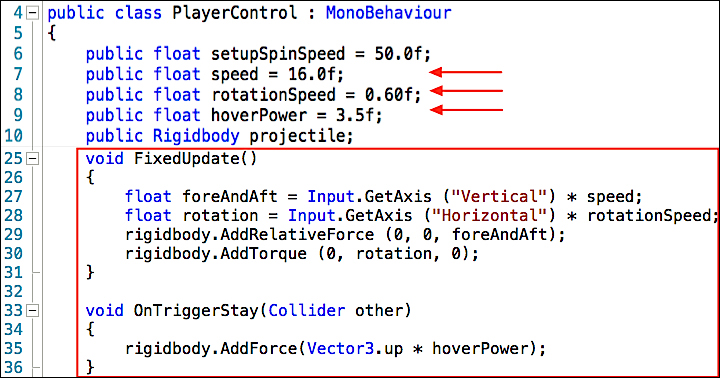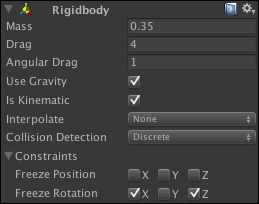We're going to add a Rigidbody Component to apply physics to Player. To stop Player from dropping like a rock, out of view of the camera, we'll check Is Kinematic in the Rigidbody properties to turn off the effect of physics. When any of the play States are active, we'll uncheck Is Kinematic in code to allow physics to affect Player.
- Select Player in the Hierarchy panel.
- At the bottom of the Inspector panel,navigate to Add Component | Physics | Rigidbody.
- In the Rigidbody Component, check Is Kinematic.
The following screenshot shows the code for moving Player using physics forces:

In the Inspector, the values stored in the Mass, Drag, and Angular Drag variables under the Rigidbody properties affect the move ability of Player, just like in real life.
In any play State, Is Kinematic is unchecked allowing physics to work.

An analysis of the code we saw in the preceding code screenshot is as follows:
Note that FixedUpdate() is being used directly in PlayerControl instead of being controlled by the State Machine:
Line 7: public floa
t speed = 16.0f;
- This variable will be used as a multiplier to make the forward and backward speed of Player faster
Line 8: public float rotationSpeed = 0.60f;
- This variable will be used as a multiplier to make Player rotate faster
Line 27: fl
oat foreAndAft = Input.GetAxis("Ver
tical") * speed;
- The
Input.GetAxis("Vertical")method detects the pressing of the Up Arrow or Down Arrow keys - The up arrow key returns a value of
1, while the down arrow key returns a value of -1 - These values are multiplied by
speedwhich contains the value16.0 - The result,
16or-16, is stored in the variableforeAndAft
Line 28: float rotation = Input.GetAxis("Horizontal") * rotationSpeed;
Input.GetAxis("Horizontal")method detects the right or left arrow keys- The right arrow key returns a value of
1, the left arrow key returns a value of-1 - These values are multiplied by
rotationSpeedwhich contains the value0.60 - The result,
0.60or-0.60, is stored in the variablerotation
Line 29: rigidbody.AddRelativeForce (0, 0, foreAndAft);
- Since we're using the
Rigidbodyclass to move Player, the Scripting Reference providesAddForce()andAddRelativeForce()for moving objects AddForce()makes objects move along the x, y, and z axes of the world, which isn't so good if Player isn't facing the direction where the force is being appliedAddRelativeForce()makes an object move according to it's own x, y, and z axes, so applying force to the z axis of Player moves it correctly
Line 30: rigidbody.AddTorque (0, rotation, 0);
Line 33: void OnTriggerStay(Collider other)
- Unity automatically calls this method when a collider of another GameObject is inside Box Collider of Player
Line 35: rigidbody.AddForce(Vector3.up * hoverPower);
- In Scripting Reference, this is one of two examples to apply upward force
- This could have been written
rigidbody.AddForce(0, hoverPower, 0); - When the Terrain is inside Box Collider of Player, upward force pushes Player up
- As Player rises higher, Terrain gets removed from Box Collider of Player
- This removes the upward force and Player lowers, causing Terrain to be detected
- This gives Player the effect of hovering over the Terrain
